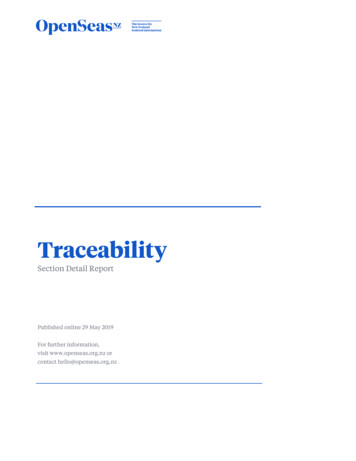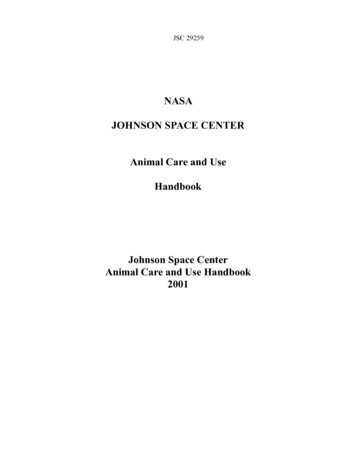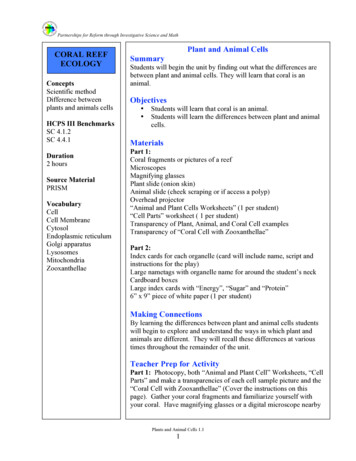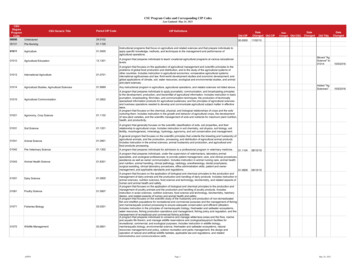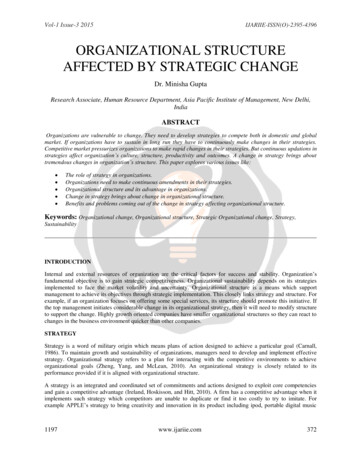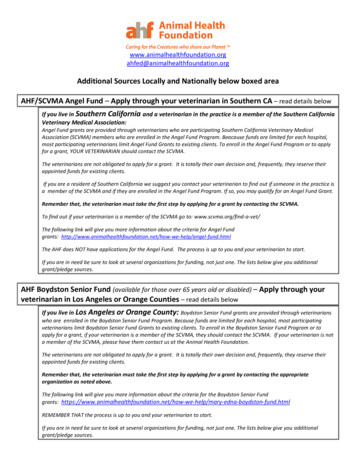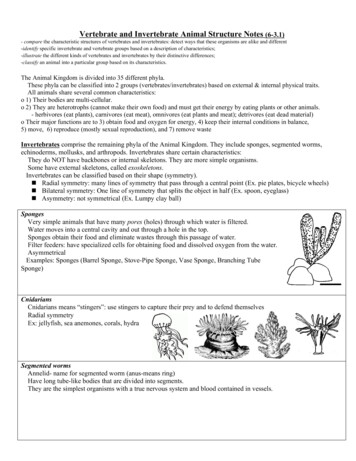
Transcription
Vertebrate and Invertebrate Animal Structure Notes (6 3.1) compare the characteristic structures of vertebrates and invertebrates: detect ways that these organisms are alike and different identify specific invertebrate and vertebrate groups based on a description of characteristics; illustrate the different kinds of vertebrates and invertebrates by their distinctive differences; classify an animal into a particular group based on its characteristics.The Animal Kingdom is divided into 35 different phyla.These phyla can be classified into 2 groups (vertebrates/invertebrates) based on external & internal physical traits.All animals share several common characteristics:o 1) Their bodies are multi cellular.o 2) They are heterotrophs (cannot make their own food) and must get their energy by eating plants or other animals. herbivores (eat plants), carnivores (eat meat), omnivores (eat plants and meat); detrivores (eat dead material)o Their major functions are to 3) obtain food and oxygen for energy, 4) keep their internal conditions in balance,5) move, 6) reproduce (mostly sexual reproduction), and 7) remove wasteInvertebrates comprise the remaining phyla of the Animal Kingdom. They include sponges, segmented worms,echinoderms, mollusks, and arthropods. Invertebrates share certain characteristics:They do NOT have backbones or internal skeletons. They are more simple organisms.Some have external skeletons, called exoskeletons.Invertebrates can be classified based on their shape (symmetry). Radial symmetry: many lines of symmetry that pass through a central point (Ex. pie plates, bicycle wheels) Bilateral symmetry: One line of symmetry that splits the object in half (Ex. spoon, eyeglass) Asymmetry: not symmetrical (Ex. Lumpy clay ball)SpongesVery simple animals that have many pores (holes) through which water is filtered.Water moves into a central cavity and out through a hole in the top.Sponges obtain their food and eliminate wastes through this passage of water.Filter feeders: have specialized cells for obtaining food and dissolved oxygen from the water.AsymmetricalExamples: Sponges (Barrel Sponge, Stove Pipe Sponge, Vase Sponge, Branching TubeSponge)CnidariansCnidarians means “stingers”: use stingers to capture their prey and to defend themselvesRadial symmetryEx: jellyfish, sea anemones, corals, hydraSegmented wormsAnnelid name for segmented worm (anus means ring)Have long tube like bodies that are divided into segments.They are the simplest organisms with a true nervous system and blood contained in vessels.
A long digestive tube runs down the length of the worm’sinner body.Worms take in dissolved oxygen from the water through their skin.Most are predators and decomposers. They obtain food using a mouth, then digest their food.Bilateral symmetryEx: earthworms, leeches, seafloor wormsEchinodermsmeans “spiny skinned” spines for protectionFive part radial symmetry: have 5 arms that extend from the middle body outwards.A water vascular system that has fluid filled tubes that when filled act as suction cups: allows them to move,exchange carbon dioxide and oxygen, capture food, and release wasteEx: sea stars, brittle stars, sea cucumbers , sea urchins, sand dollarMollusksHave unsegmented soft bodies; most have a thick muscular foot for movement, eating, or to open and close theirshells. Some are filter feeders.They have more developed body systems than sponges or worms.They take in oxygen through gills or lungs, and some have shells.Bilateral symmetryEx: octopi, squid, snails, slugs (no shell), clams, oysters, scallops, cuttlefish, na utilusArthropodsArthropod means “jointed foot”Have jointed legs, segmented bodies, some have wings, exoskeletons (hard outer covering), mandible jaws forchewing foodThey obtain oxygen from the air through gills or spiracles (air tubes)Bilateral symmetryEx: insects (flies, ants, beetles, bees, grasshoppers), centipedes and millipedes, arachnids (spiders, ticks, scorpions),and crustaceans (lobsters, shrimp, crabs)
Vertebrate AnimalsVertebrates comprise only one phylum of animals. They include fish, amphibians,reptiles, birds, and mammals. Vertebrates share certain physical characteristics:They have backbones, an internal skeleton (endoskeleton) for muscle attachment andgrowth, and muscles.They have blood that circulates through blood vessels and lungs (or gills) for breathing.They have a protective skin covering.Most have legs, wings, or fins for movement.They have a nervous system w/ a brain that processes information from theirenvironment through sensory organs. They are more complex organisms.Vertebrates differ in the way that they control their body temperature.In some (fishes, amphibians, and reptiles), their body temperature is close to that of their environment. They areconsidered cold blooded, or ectothermic.In others (birds and mammals), their body temperature stays constant regardless of the temperature of theenvironment. They are called warm blooded, or endothermic.FishAre cold blooded (ectothermic); most obtain dissolved oxygen in water through gills; most lay eggs;have scales; have fins; and live in water.AmphibiansAre cold blooded (ectothermic); most can breathe in water with gills as young, and breathe on land with lungs asadults; go through metamorphosis; lay jelly like eggs.The major groups of amphibians are frogs, toads, and salamanders.Frogs and salamanders have smooth, moist skin,through which they can breathe and livepart of their life in water and part on land.Toads have thicker, bumpy skin and live on land.ReptilesAre cold blooded (ectothermic); breathe with lungs; mostlay amniotic (covered) eggs,although in so me the eggs hatchinside the female; and have scales orplates.Eggs, skin, and kidneys areadapted toconserve waterEx: snakes, lizards, turtles,alligators, and crocodilesBirdsAre warm blooded (endothermic); breathe with lungs; lay eggs; have feathers; and have a beak, two wings,and two feet. Most are adapted to fly
MammalsAre warm blooded (endothermic); breathe with lungs; most have babies that are born live (not hatched from an egg);skin covered with fur or hair; and nourish young with milk produced by mother.The 3 types of mammals are: Monotremes (ex. platypus). Marsupials (ex.kangaroo, opossum), and Placentals (ex. human, ho rse).1) Which are vertebrates? a. hamster b. crab c. koala d. spider2) Which are vertebrates? a. alligator b. fish c. dolphin d. bird3) What do all vertebrates have in common?a. They live on land.b. They all have a hard internal skeleton or backbone.c. They all have legs.d. They are all warm blooded.4) Vertebrates include which types of animals?A. Mammals B. Fish C. Amphibians D. Reptiles E. All of the following5) Which are invertebrates? a. frog b. dragonfly c. worms d. fish6) Which are invertebrates? a. spider b. crab c. bird d. starfish7) What do all invertebrates have in common?a) They all have a soft skeleton made of fluid.b) They all have a hard external skeleton.c) They don't have a hard internal skeleton.d) They are all cold blooded.8) Invertebrates include which types of animals?a) Protozoa b) Mollusksc) Crustaceansd) Insectse) All of the following9) Which of the following is a characteristic shared by all animals?A. Their bodies have many cells.B. They eat autotrophs.C. They reproduce asexually.D. They have skeletons.10) An animal has bilateral symmetry if .A. no lines can be drawn to divide the animal into halves that are mirror images.B. many lines can be drawn to divide the animal into halves that are mirror images.C. one line can be drawn to divide the animal into halves that are mirror images.D. any line through the center of the animal divides it into halves that are mirror images.11) Which of the following is true of all mollusks?A. They have shells.C. They have segments.B. They have soft bodies.D. They have gills.12) An arthropod’s tough outer covering is called .A. an endoskeleton B. an exoskeleton C. armorD. a mantle13) Fish take in oxygen through their .A. fins B. gills C. scalesD. vertebrae14) Birds are the only animals that have A. scalesB. feathersC. nests D. a heart w/ 4 chambers15) An animal whose body temperature does not change much, even when the temperature of the environment changes, is called .a temperature regulator B. a cold blooded animal C. an endotherm D. an ectotherm16) Which of the following are all endotherms?A. reptiles and amphibiansB. birds and mammalsC. fish and birds D. reptiles and mammals17) This animal is a(n) . A. reptileB. amphibianC. mammalD. cnidarian18) This animal has .A. an exoskeleton B. jointed limbs C. a segmented bodyD. all of the following19) This animal belongs to the group of invertebrates called .A. arthropodsC. echinodermsB. cnidariansD. mollusks20) An animal whose body temperature stays close to that of its surroundings is a(n) .21) What is an internal skeleton called?22) What kind of symmetry has multiple lines that radiate from a central point?23) What is a hard external skeleton called?Word bank for 24: arthropods, cnidarians, echinoderms, mollusks, sponges, wormsa. Full of pores b. Joint limbed A.
c. Stingers d. Insects, spiders, and lobsters are members e. Sea urchins and starfish are members Word bank for 25:amphibians, birds, fish, mammals, reptilesa. Alligators and snakes are members b. Bats, whales, and cats are members c. Sharks are members d. Undergo metamorphosis
B. many lines can be drawn to divide the animal into halves that are mirror images. C. one line can be drawn to divide the animal into halves that are mirror images. D. any line through the center of the animal divide
